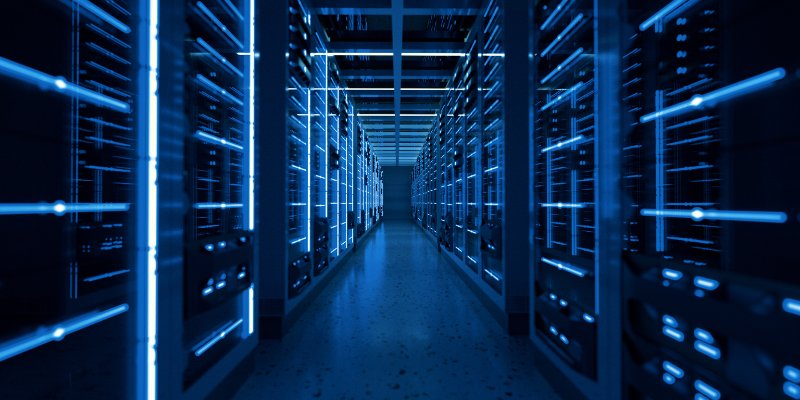
Strategies for Data Center Optimization
Jan 31, 2024 By Mark Allen
Technology-driven corporations need data center optimization. Operating performance depends on data center efficiency and effectiveness as data volumes rise and technology changes. Cloud computing, careful network and storage management, smart physical space usage, and virtualization technologies are crucial to data center efficiency. Cloud computing's dynamic scalability and cost-effective resource allocation are crucial to data center efficiency. Manage network and storage systems to ensure operational resilience and data flow across the infrastructure. Strategic physical space utilization and virtualization let data centers adapt to changing workloads and technological paradigms.

Why Data Center Optimization Is Essential:
Due to technological dependence, contemporary businesses need data center optimization. Optimization boosts operational efficiency, helping data centers meet corporate expectations. This requires intelligent resource allocation of computer power, storage, and networking to optimize production and minimize waste. Streamlining these resources helps provide a more responsive and flexible infrastructure that adjusts to shifting workloads and operational needs.
Cost savings come from data center optimization beyond efficiency increases. Careful optimization may save infrastructure, energy, and maintenance costs. Reducing data center operations' environmental effects saves money and promotes sustainability. Optimization boosts performance and dependability. An efficient data center can manage current technology's complexity, ensuring that it maintains a reliable backbone for an organization's digital activities. Data center optimization is essential for operational efficiency, cost-effectiveness, and agility as enterprises traverse the digital world.
Key Elements Of Data Center Optimization:
Data center optimization focuses on efficiency-boosting factors to maximize performance. Cloud computing, network and storage management, space utilization, and virtualization are examples.
Cloud computing:
Cloud computing underpins data center optimization. Cloud services allow enterprises to flexibly expand computer resources depending on demand, minimizing the requirement for on-premises infrastructure. Cloud solutions are flexible, cost-effective, and can offload workloads, freeing up internal resources for crucial activities.
Network And Storage:
Data center optimization requires efficient network and storage management. Improved performance comes from data transport, latency, and storage optimization. Advanced technologies like SDN and NFV improve network capabilities.
Physical Space:
Optimizing data centers requires optimal space use. Layout design, cable management, and cooling systems improve physical infrastructure. Space optimization maximizes resources without sacrificing safety or accessibility.
Virtualization:
Virtualization lets you create virtual servers, storage, and network resources to maximize hardware use. This technique decreases server footprint, improves resource allocation, and simplifies scaling.
Ways Data Centers Can Consume Less Energy:
Data center optimization emphasizes energy efficiency to reduce expenses and environmental impact. Several methods to reduce energy use:

Using Liquid Cooling Technology:
Innovative liquid cooling technology manages data center temperatures effectively. This approach absorbs and removes server and hardware heat by circulating liquid coolant via specialized devices. Air cooling is less precise than liquid cooling, which directly cools heated components like computers. Focused cooling reduces temperature control energy use, saving money and the environment. Although liquid cooling costs more, it reduces energy expenses and improves equipment durability, making it a good option for data centers, particularly high-performance computing settings.
Infrastructure design and possible obstacles must be considered before using liquid cooling. Integration with current systems, maintenance, and cost-effectiveness are key. Despite these issues, liquid cooling is a promising heat dissipation technology for data centers.
Consolidating Servers:
The consolidation of several servers into a single, more powerful machine has many benefits for data center optimization. This method maximizes resource efficiency and decreases data center footprint by removing unneeded or obsolete hardware. By running numerous virtual servers on a single physical server, consolidation improves operational efficiency. The advantages include reduced energy use, easier management, and operational agility. Server consolidation helps achieve sustainability objectives by saving money and the environment.
Server consolidation has advantages, but it needs careful planning to avoid issues. Virtualization, task allocation, and performance monitoring must be considered. Server consolidation requires a thorough grasp of the organization's computing demands and a well-executed deployment strategy.
Using Renewable Energy:
Solar and wind power may make data centers more sustainable. Traditional data centers using non-renewable energy cause environmental issues. Renewable energy lets data centers create clean energy on-site, decreasing power grid dependence. Renewable energy supports business sustainability objectives and has economic and environmental advantages for data centers.
Renewable energy infrastructure investment may be difficult, but the long-term benefits are worth it. Renewable energy sources may save money and boost the brand image of environmentally conscious companies. As renewable technologies evolve, data centers using them help create a greener IT environment.
Raising the Temperature:
Data center temperature adjustments are simple and energy-saving. Modern hardware works well at greater temperatures, whereas traditional procedures maintain lower temperatures for equipment durability. Data centers may minimize cooling system effort by lowering temperature set points to the optimum range. Higher energy efficiency, lower energy consumption, and cheaper cooling infrastructure running expenses occur.
Temperature adjustments must be monitored and considered for hardware performance: gradual adjustments and ongoing monitoring balance energy savings and equipment dependability. Sustainable data center methods include raising temperature set points to save energy without impacting IT infrastructure.
Using Efficient Hardware:
Data centers may reduce power usage and optimize performance by using energy-efficient gear. Servers, storage, networking, and other energy-efficient technology run at peak efficiency. This technique saves energy, decreases environmental impact, and promotes sustainable data center procedures.
Considerations include upfront investment expenses, compatibility with current systems, and long-term operating advantages when adopting energy-efficient gear. Energy-efficient hardware is a good investment for data centers that want to maximize performance and reduce environmental impact despite upfront expenses.
Conclusion:
In conclusion, data center optimization is essential for companies navigating current technologies. Data center operational excellence relies on cloud computing resource management, network and storage system maintenance, space optimization, and virtualization technology adoption. Beyond these pillars, data center networking best practices and energy-efficient solutions are crucial to sustainability and cost-effectiveness. Data center optimization is essential for digital success as organizations increasingly rely on durable and high-performing data infrastructure.
-
 Entertainment Jan 31, 2024
Entertainment Jan 31, 2024Hot Wheels Unleashed 2 Turbocharged Review
Discover the details of the Hot Wheels unleashed 2 turbocharged action-packed racing game with exhilarating gameplay, brand-new tracks, and incredible car customization
-
 Entertainment Feb 01, 2024
Entertainment Feb 01, 2024Love Again: A Predictable but Enjoyable Romance with an Amazing Cast
Have you heard about the romantic comedy movie starring Priyanka Chopra, Love Again? If not, here’s what’s in for you in this movie.
-
 Internet & Telecom Jan 30, 2024
Internet & Telecom Jan 30, 2024Unpacking SOA (Service-Oriented Architecture)
SOA, a revolutionary software design and development method that creates modular, adaptable, and scalable systems that integrate across applications and platforms.
-
 Entertainment Feb 02, 2024
Entertainment Feb 02, 2024The Top 10 Favorites Based on Audience Surveys
Dive into the heart of American sports culture as we analyze audience preferences through surveys, revealing insights into the ten most popular sports in the USA.